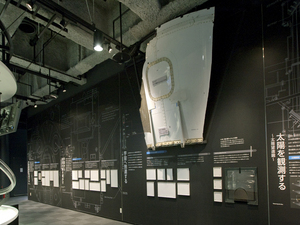Nagoya City Science Museum
TOP > Exhibition Guide > Floor Map> The H-IIB launch vehicle
The H-IIB launch vehicle



Purpose of Exhibition
Rockets utilize the latest technology and materials, and they have the characteristic of being light and strong.
After launching, while enduring air resistance, a rocket reaches its top speed of eight kilometers per second before finally breaking away from earth's gravity and reaching space.
The made-in-Japan-rockets, H-IIA type, and H-IIB type are currently the mainstream rockets in Japan. The H-IIA rocket launches satellites and probes. The H-IIB rocket supplies the International Space Station with goods. The HTV (H-11 transfer vehicle) is the world's largest rocket launcher.
In this exhibition, we will explain the rocket which is loaded with the latest technology, using fairing which begins the manufacturing process, and accompanying pictures from the rocket manufacture to launch, with a real cut model of an M-V rocket (This includes the edge of the rockets, the parts that protect the satellite, and other actual components.).
Additional Knowledge
[The Nagoya Area is the Center of the Japanese Rockets Production]
Japan's mainstream rockets, the H-IIA rocket and the H-IIB rocket main first and second rocket tanks, and similarly the first and second engines, are produced in Nagoya and neighboring factories. Their fairing is designed in companies in Gifu prefecture. These parts make up most of the rockets. That's why it is said that the "local- made" rocket flies into space.
[Light, Strong Materials and Structure]
The H-IIB rocket detaches the fairing at a high altitude of approximately 120km. Then the fairing falls into the sea.
Because of the impact, it falls apart, but most of the parts don't sink, they stay afloat because of the lightness of the materials. These are recovered by ships for maritime safety.
The fairing of the exhibit is the real thing that actually flew to space and came back.
Fairing is made of thin planks, and mainly aluminum is used for the outside surface, the inside surface and the inner structure. Especially the internal structure which is built like a bees nest (honeycomb structure), which remains lightweight while maintaining strength.
To maintain the shape, a structure has been attached to the external portion, but that part becomes very hot when the rocket rises and the air resistance increases. But because it has been made from special material, it can withstand high temperatures. The fairing is made of various devices piled, but assembled mostly by hand, using cutting edge technology and skilled technique.
[M-V rockets fairing uses carbon]
The M-V rockets are middle-size rockets, used for the launching of the asteroid space probe "Hayabusa". The fairing duty is to protect the probe from the force and heat of the air flow and sound at launch and when flying.
As for the fairing of M-V too, honeycomb-shaped planks are used, but inside and outside panels are made using two plates of CFRP (Carbon fiber). The whole fairing is 9 meters in length and 2.5 meters in diameter, but it only weighs 700 kg.
In the exhibit, you can lift it from the bottom and feel its lightness.
Cooperation: Japan Aerospace Exploration AgencyMITSUBISHI HEAVY INDUSTRIES, Ltd.
Kawasaki Heavy Industries, Ltd.
Article by Masao Suzuki, curator
